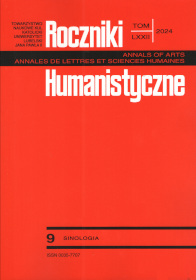MITOREALIZM 神实主义YANA LIANKE阎连科.
W KRĘGU REALIZMU MAGICZNEGO, GROTESKOWEGO
I WEWNĘTRZNEJ PRAWDY O CHIŃSKIEJ RZECZYWISTOŚCI
MYTHOREALISM 神实主义OF YAN LIANKE阎连科.
IN THE REALM OF MAGICAL REALISM, GROTESQUE REALISM
AND THE INNER TRUTH OF CHINESE REALITY
Author(s): Lidia KasarełłoSubject(s): Other Language Literature, Theory of Literature, Sociology of Literature
Published by: Towarzystwo Naukowe KUL & Katolicki Uniwersytet Lubelski Jana Pawła II
Keywords: Yan Lianke; mythorealism; magical realism; grotesque realism; paratextuality; metatex- tuality; narrative and linguistic strategies; self-censorship;
Summary/Abstract: This research paper is entirely devoted to the attempt to define and analyze the essence and dis-tinctive features of a Chinese literary concept proposed by Yan Lianke (1958). He himself appears inthe article in a dual role, once as the creator of many outstanding contemporary novels – includingsix translated into Polish between 2019 and 2023 (Dream of Ding Village, The Explosion Chronicles,The Four Books, Lenin’s Kisses, The Day the Sun Died, Heart Sutra) – and twice as the author ofin-depth reflections on variations of realism and causality in literature (the book Faxian xiaoshuo).Yan Lianke’s considerations serve as a starting point and at the same time as a context for placing thephenomenon of mythorealism in the history of Chinese literature, both in the old novelistic tradition,in the stories of Lu Xun, and above all in the literature of the New Period (mainly xungen wenxue andMo Yan). The analysis of the six novels shows that mythorealism is a kind of artistic vehicle that al-lows for the unveiling of “the inner truth” about the absurd and chaotic reality of contemporary China.Since this truth is concealed from rational recognition of “inner causality,” the later part of the articleseeks familiar literary models and strategies to explain the complexity of Yan’s mythorealism. To thisend, similarities and differences between mythorealism and its closest counterparts, magical realismand grotesque realism, are first discussed, followed by a section dedicated to para and meta-textualityas well as narrative and linguistic strategies, citing examples of the presence of elements of magical orgrotesque realism in Yan’s mythorealistic novels. Interpretative explanations of the six novels, richlyillustrated with examples, precede an extensive section on the ambiguity and role of self-censorshipin Yan Lianke’s mythorealistic creation, which uses allusion, magic, grotesque, absurdity, and allegor-ical mode to deal with the trauma of the past and critique contemporary Chinese reality.
Journal: Roczniki Humanistyczne
- Issue Year: 72/2024
- Issue No: 9
- Page Range: 19-44
- Page Count: 26
- Language: Polish

